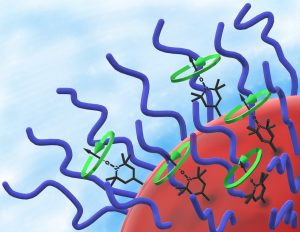Peptide Block Copolymers:
Responsive Peptides and Protein Bioconjugates
One of the main research goals in the Savin group is to understand and control the assembly and responsiveness of polypeptide-based and bioconjugate block copolymers in solution. Synthetic polypeptides in solution can be used as a model for synthetic polyelectrolytes due to the ability to control the charge-charge interactions between ionizable units. In addition, by using polypeptides we can incorporate pH and temperature responsiveness into a material based in part on the secondary structure changes that occur within the peptide chain. Finally, we can dictate the geometry of specific interactions to induce folding and assembly into responsive hydrogels, crosslinked core-shell structures and multiply-responsive shape change materials. The use of polypeptides in these materials introduces an immense toolbox that allows for control over the specific structure-property relationships that govern the resultant material.
Our recent work in this area has focused on (1) incorporating EPR spin labels into the block copolymer assemblies to assess local hydrophobicity and chain dynamics (in collaboration with the Fanucci Group), (2) formation of protein fractals through diffusion limited aggregation and incorporation of specific peptide interactions, and (3) construction of protein/polymer bioconjugates by marrying recombinant DNA approaches with polymer grafting reactions.
Our principal analytical tools are static and dynamic light scattering, although although we invoke most polymer solution characterization techniques. We also use electron paramagnetic resonance and Overhauser dynamic nuclear polarization to characterize the local environment in the vicinity of the spin label. For peptide gels we use rheology, and we rely on microscopy (TEM) for morphology characterization.

